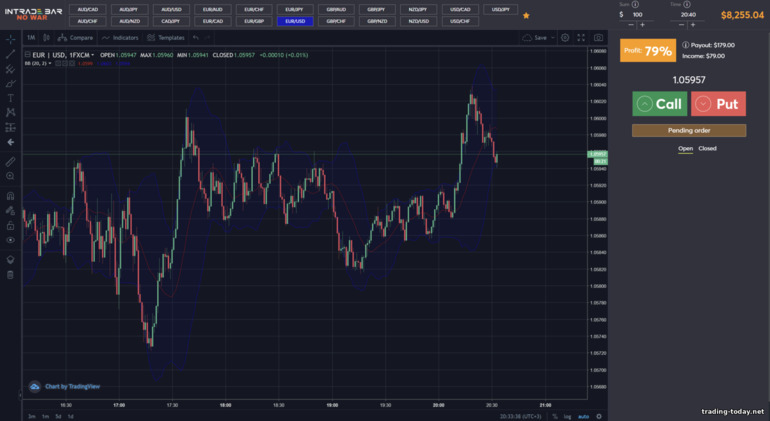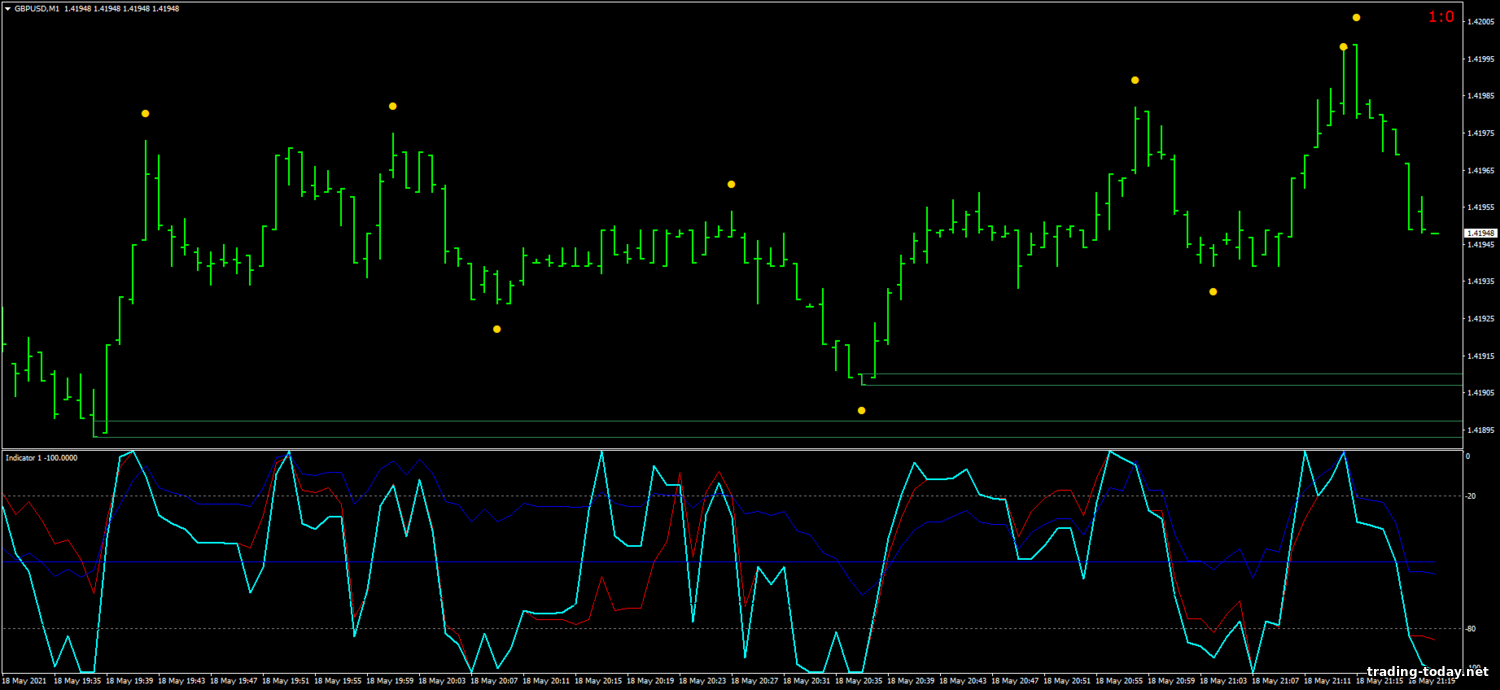Effective Trading Plan for Binary Options: Trader's Guide
Updated: 21.03.2025
Trading plan for a Binary Options trader: algorithm for the correct actions in trading Binary options (2025)
Have you ever wondered how professional Binary Options traders make money? If you look at their work from the outside, you might think that trading is a very simple activity that anyone can handle. All actions of a professional trader are logical, and transactions are opened with extraordinary ease. But, have you tried to repeat these steps personally?
It immediately becomes clear that trading is not so easy, and some trading points are completely hidden behind a thick wall of misunderstanding. How so? Why is there such a huge difference between the trading of a professional trader and a novice trader, despite the fact that the actions will be very similar? The fact is that an experienced trader has his own trading plan, which a novice trader does not have.
Trading plan is a set of algorithms for all trading cases. Simply put, for any situation during trading, an experienced trader has an action plan that will reduce losses and increase profits. It is the trading plan that we will talk about today.
If we take the opposite of this fact, we get: “Any strategy can make a profit with the right approach to trading.” Literally, if a trader has good fundamental knowledge about trading, then in his hands even the most unprofitable, at first glance, strategy will bring profit. If a trader does not have such knowledge, then even the most profitable, in the opinion of a large number of experienced traders, strategies will only bring losses.
You don’t need to look far for examples - trading using Bollinger bands. Some will say that this is pointless - there will be much more losing trades than profitable ones. Some will say that this is the pure Grail, which allows you to make a profit both during a flat and during a trend. What if I told you that trading Bollinger Bands is the best trading method of all? Are you really going to start trading right away? Most likely no! What if I not only say, but also show in practice that this indicator is capable of showing a very large number of profitable signals? Most of you will try your hand and fail.
We have already found out the reason for this failure. I have:
Think about yourself while trading. You:
A trading plan solves all these problems that prevent you from making money in trading. All you need to do is strictly follow your trading plan! Those. you must have good discipline – no “today I will follow a trading plan, but won’t tomorrow” should not happen!
The situation is similar with the trading plan. Violating your trading plan is tantamount to driving into oncoming traffic - if you are lucky, you will get off with a slight fright, if you are unlucky, then you can forget about your trading deposit. Think about it, do you need it?! It’s much easier to get from point “A” to point “B” by following all the rules - it’s safer, and the likelihood of a positive outcome is very high. The only difference is in the speed (and that’s not a fact) of achieving the goal, but if you rush, then you may not get to the goal at all, but if you do everything without haste, then sooner or later the goal will be achieved - “if you drive more quietly, you will continue!” .
Any violations of the trading plan will always lead to only one thing - loss of money. If this doesn’t scare you, then break these rules at least every day - someone has to give their money so that others can earn it.
For unprofitable transactions, conscious ones are transactions that were also made according to all the rules. Having losing trades is normal. There are no 100% trading systems or techniques. Random losing trades are the price to pay for your careless attitude towards trading. You yourself opened a deal where there was no need to open it, and you yourself pay for such “pleasure”!
The opposite situation is similar - when the goals were achieved too early. In this case, you have set the level “too easy” for yourself - do not hesitate to raise the bar. Always be realistic!
Of course, all risks will be selected individually. For some traders, the “Three shots and you’re dead!” rule will be very important, but for others, this rule does not work, and they can easily withstand longer drawdowns of the deposit. Everything here very much depends on your trading methods and the stability of your psychological state.
Similarly, you need to set rules for profit. The following rules work very well:
As a result, according to risk management, you should have the following plan:
Plan your trading time in advance. There is no point in trading after a tiring day at work when you come home and feel like you're dead on your feet. Think about possible fatigue in advance. Trading itself is very exhausting, so 1-4 hours a day is enough for trading.
Also, there are cases when a signal according to your strategy appears at the same time. For example, at the opening of a trading session. In this case, write this in your trading plan - “At 10:00 Moscow time you need to make 3 transactions on assets (EUR/USD, EUR/JPY, USD/CAD) according to strategy N, investment in each transaction is 2%, expiration time – 30 minutes.”
Indicate everything specifically - what and how you will do. This will help you a lot during trading - the action plan is already known, so you just need to do what you wrote the day before. Plus, you simply won’t have situations like “Ahhh! I don’t know what to do now!” - everything has been thought out for a long time.
The set goals should NOT violate the rules of risk management and money management! It is best to set monthly goals based on your trading balance. It’s unlikely that you’ll be able to earn a million with $10,000, but earning 2-3 thousand is quite possible!
First of all, think with your head, not with your “desires”. If you want to earn a lot, have a trade balance that allows you to achieve such goals painlessly and calmly. Otherwise, you will only waste your money, because... unrealistic goals will force you to break the rules of risk management, and this is only a one-way road.
Your trading plan should also include an action algorithm that takes into account your emotional or physical state before (and during) trading:
Very often it is worth listening to smarter people who know their business - they will teach you to overcome difficulties. So, your trading plan is the same experienced trader that you are without external interference. Allow yourself not to ask questions or doubts, but simply follow what you wrote earlier!
Believe me, this is the surest way to achieve success - not to think about the consequences at all, but simply follow the algorithms that are written in your personal trading plan. Moreover, it doesn’t matter at all what the result of your trading will be:
Don’t put the goal “Make a million” in the first place; put the goal “Strictly follow the rules of the trading plan!” in the first place.
A trading plan is a tool for your trading that will allow you to reach a very important stage - to stop losing money. And then, when you are firmly on your feet, you can move on to improving your results.
It immediately becomes clear that trading is not so easy, and some trading points are completely hidden behind a thick wall of misunderstanding. How so? Why is there such a huge difference between the trading of a professional trader and a novice trader, despite the fact that the actions will be very similar? The fact is that an experienced trader has his own trading plan, which a novice trader does not have.
Trading plan is a set of algorithms for all trading cases. Simply put, for any situation during trading, an experienced trader has an action plan that will reduce losses and increase profits. It is the trading plan that we will talk about today.
Contents
- The best and most profitable strategy on Binary Options
- Trading plan for a binary trader: why is it needed
- What happens if you violate your trading plan
- Binary options trades: profitable and unprofitable forecasts
- Creating a trading plan for a Binary Options trader
- Goals in trading Binary options
- Money management in the trading plan of a Binary Options trader
- Time management and trading time in a trader’s trading plan
- Expected profit per month on Binary Options
- Preparing to trade Binary Options
- Don’t deviate from your trading plan
- Trading plan in Binary options: summary
The best and most profitable strategy on Binary Options
Many of you, and I at one time, spent a lot of energy searching for that very Grail - the best trading strategy that would make me a millionaire on Binary Options within 24 hours. As you understand, all these searches were in vain. But every trader must go through this path before understanding the simple truth - a maximum of 10% of success in Binary Options trading depends on strategy.If we take the opposite of this fact, we get: “Any strategy can make a profit with the right approach to trading.” Literally, if a trader has good fundamental knowledge about trading, then in his hands even the most unprofitable, at first glance, strategy will bring profit. If a trader does not have such knowledge, then even the most profitable, in the opinion of a large number of experienced traders, strategies will only bring losses.
You don’t need to look far for examples - trading using Bollinger bands. Some will say that this is pointless - there will be much more losing trades than profitable ones. Some will say that this is the pure Grail, which allows you to make a profit both during a flat and during a trend. What if I told you that trading Bollinger Bands is the best trading method of all? Are you really going to start trading right away? Most likely no! What if I not only say, but also show in practice that this indicator is capable of showing a very large number of profitable signals? Most of you will try your hand and fail.
We have already found out the reason for this failure. I have:
- Knowledge in trading psychology
- Knowledge in trading discipline
- Knowledge in risk management and money management
- Trading plan
- Bare strategy – only 10% of success out of the required 100%
Trading plan for a binary trader: why is it needed
Many of you will ask the question – “Why is this trading plan needed at all? I can trade without him, so why do I need him now?” Of course, you traded without a trading plan, but what are the results of this trade?! Here it comes - a trading plan is needed to improve your trading results, and besides, without a trading plan, you can’t expect stable results. Any positive result without a trading plan is pure chance or luck, but not a pattern. On the other hand, there is no 100% guarantee in trading, and there never will be - it all depends on you. But, a trading plan allows you to very competently designate the path that you should follow on the path to success.Think about yourself while trading. You:
- Very strongly influenced by emotions
- Make transactions wherever you want
- You don’t make deals where you need to
- You invest different amounts in transactions, hoping to make a big profit or get back what you lost
- You have overtrading
- You jump from one trading strategy to another
- You do not have clear rules indicating when to stop trading
- You do not have time management
A trading plan solves all these problems that prevent you from making money in trading. All you need to do is strictly follow your trading plan! Those. you must have good discipline – no “today I will follow a trading plan, but won’t tomorrow” should not happen!
What happens if you violate the trading plan
Have you ever driven a car? What do you think will happen if you break traffic rules? At best, everything will end with a simple fine, at worst - with more dire consequences. You understand this very well, so you always try to follow the traffic rules - it is NECESSARY, even if you don’t feel like it.The situation is similar with the trading plan. Violating your trading plan is tantamount to driving into oncoming traffic - if you are lucky, you will get off with a slight fright, if you are unlucky, then you can forget about your trading deposit. Think about it, do you need it?! It’s much easier to get from point “A” to point “B” by following all the rules - it’s safer, and the likelihood of a positive outcome is very high. The only difference is in the speed (and that’s not a fact) of achieving the goal, but if you rush, then you may not get to the goal at all, but if you do everything without haste, then sooner or later the goal will be achieved - “if you drive more quietly, you will continue!” .
Any violations of the trading plan will always lead to only one thing - loss of money. If this doesn’t scare you, then break these rules at least every day - someone has to give their money so that others can earn it.
Binary options trades: profitable and unprofitable forecasts
Any transactions on Binary options are divided into two types:- Conscious
- Random
For unprofitable transactions, conscious ones are transactions that were also made according to all the rules. Having losing trades is normal. There are no 100% trading systems or techniques. Random losing trades are the price to pay for your careless attitude towards trading. You yourself opened a deal where there was no need to open it, and you yourself pay for such “pleasure”!
Creating a trading plan for a Binary Options trader
As I already said, a trading plan is a set of strict algorithms that must be prescribed for any trading situation:- Profit plan
- Loss plan
- Strategy plan
- Plan for the number of transactions
- Plan for trading time
- Plan for risks in trading
- Plan for emotions in trading
- Plan for a trading diary
- Plan for preparing for trading
- Plan to break the plan!
- Losses have begun - in this case you need to do this, this and this
- The limit on the number of transactions has been reached - there are strict rules for this case too
- Violation of risk management rules - the following algorithm will indicate further correct actions
- Failure to comply with the trading plan - even in this case there is an algorithm of actions
Goals in trading Binary options
Any trading goals must strictly meet 5 points. The goals should be:- Specific
- Limited in time
- Real
- Achievable
- Measurable
- Do you want to earn how much money? 1 dollar or 100 thousand greenbacks?
- For what time period? In a day or in 45 years?
- Real - no fantastic requirements, everything is within the acceptable limits
- Specific – a specific amount of 20% is indicated
- Limited in time - everything needs to be done in a month
- Achievable - earning 20% in a month is not so difficult
- Measurable - profit 20% of the deposit
The opposite situation is similar - when the goals were achieved too early. In this case, you have set the level “too easy” for yourself - do not hesitate to raise the bar. Always be realistic!
Money management in the trading plan of a Binary options trader
About money management and risk management we have said repeatedly. These rules should be written down in your trading plan! You should always have rules for situations where:- You are incurring losses - should you stop or continue trading? Why?
- Are you making money – should you stop there or continue trading? Why?
- Loss limit – trading must be completed
- Profit limit - trading must be completed
- Trade limit - trading must be completed
- Time limit - trading must be completed
- Risk per trade (how much you can afford to lose in one trade)
- Daily risk (how much are you willing to lose on this day if the trade is unprofitable)
Of course, all risks will be selected individually. For some traders, the “Three shots and you’re dead!” rule will be very important, but for others, this rule does not work, and they can easily withstand longer drawdowns of the deposit. Everything here very much depends on your trading methods and the stability of your psychological state.
Similarly, you need to set rules for profit. The following rules work very well:
- The daily profit limit has been reached, but trading was difficult - you need to stop trading
- The daily profit limit has been reached and trading has been easy - you can continue trading
- Trading should be completed when a certain amount is reached
- Trading should be ended if you lose 10-50% of the profit received
As a result, according to risk management, you should have the following plan:
- We start trading according to the established rules of the Republic of Moldova
- Has the limit been reached (losses, profits, transactions, time)?
- Yes - we are finishing trading
- No –
- We continue trading according to the rules of the Republic of Moldova
- Checking limits
Time management and trading time in the trader’s trading plan
Trading time depends on the trading strategies used, your preferences and the availability of free time. The trading plan itself is best written the day before trading - in such a situation you can think about everything and draw the right conclusions. The same is true with time management in a trading plan:- Decide on the trading strategy you will use
- Select the current time to trade using this strategy
- Make adjustments by watching the release of important economic news
Plan your trading time in advance. There is no point in trading after a tiring day at work when you come home and feel like you're dead on your feet. Think about possible fatigue in advance. Trading itself is very exhausting, so 1-4 hours a day is enough for trading.
Also, there are cases when a signal according to your strategy appears at the same time. For example, at the opening of a trading session. In this case, write this in your trading plan - “At 10:00 Moscow time you need to make 3 transactions on assets (EUR/USD, EUR/JPY, USD/CAD) according to strategy N, investment in each transaction is 2%, expiration time – 30 minutes.”
Indicate everything specifically - what and how you will do. This will help you a lot during trading - the action plan is already known, so you just need to do what you wrote the day before. Plus, you simply won’t have situations like “Ahhh! I don’t know what to do now!” - everything has been thought out for a long time.
Expected profit per month on Binary options
In trading it is impossible to be sure of anything - this is a fact. But what prevents us from making plans?! So, before the start of each month, you should think carefully about what goals to set for the future. Everything here is also very individual:- For some, 10% will be enough
- Someone will be upset if they earn less than $100 thousand
- And someone will be happy if they close the month without losses
The set goals should NOT violate the rules of risk management and money management! It is best to set monthly goals based on your trading balance. It’s unlikely that you’ll be able to earn a million with $10,000, but earning 2-3 thousand is quite possible!
First of all, think with your head, not with your “desires”. If you want to earn a lot, have a trade balance that allows you to achieve such goals painlessly and calmly. Otherwise, you will only waste your money, because... unrealistic goals will force you to break the rules of risk management, and this is only a one-way road.
Preparing to trade Binary Options
Preparing to trade Binary Options includes a number of urgent matters. Necessary:- Analyze your last trading session and all transactions (draw conclusions)
- Based on these conclusions, adjust the trading plan (if necessary)
- Immediately before trading, you need to check the economic calendar again - suddenly something has changed
- Check the profitability of your assets, if your broker has a floating payout percentage for a correct forecast - perhaps your strategy is designed for high payouts and will not work on low payouts
Your trading plan should also include an action algorithm that takes into account your emotional or physical state before (and during) trading:
- I didn’t get enough sleep - I missed the first scheduled trading session, because... I can’t trade profitably in such a situation. I spend an hour trying to get back to normal. If I have time, I start trading according to plan “B” using the specified trading strategy. If I’m still sleepy, I put off trading until the evening (there should be a plan for this trading too!)
- I came home tired from work - I put off trading until tomorrow
- Before trading, a fear of loss appeared - I took a break from trading for a couple of hours and tried to restore the desired emotional state. It worked out - I’m starting to trade according to plan “B”. It didn’t work out - I put off trading until I find out the reasons and correct my trading plan
- Checking your readiness to trade. Cheerful, I’m sure everything is going according to plan – I’m starting trading. Something goes wrong - I use plan B
Strategies and tools used in Binary Options trading
Briefly describe all the tools used, whether charts, economic calendars or strategies. By the way, it would not be amiss to describe your trading methodology (strategy) with the same rules “If... Then...”, thereby creating an algorithm of actions when a signal appears. For example:- The price has moved beyond the upper line of the Bollinger Bands indicator
- The RSI indicator line is above the “80” level
- I open a bear trade with a risk of 1% of the balance
- Expiration time 5 minutes
Don't deviate from your trading plan
Remember one thing - a trading plan is needed in order to guide you by the hand in the surest way from the start of trading to receiving your profit. Accordingly, you should never violate your trading plan - strictly follow your own rules! If you have any questions or doubts during trading, know that you created your trading plan when you were not influenced by external factors! You approached creating a plan when you could soberly assess the situation - there were no worries, fears, doubts. So why are you doubting your trading plan now while trading? Now you are under pressure from emotions, thirst for profit or greed. Now you are wrong, but your trading plan is right!Very often it is worth listening to smarter people who know their business - they will teach you to overcome difficulties. So, your trading plan is the same experienced trader that you are without external interference. Allow yourself not to ask questions or doubts, but simply follow what you wrote earlier!
Believe me, this is the surest way to achieve success - not to think about the consequences at all, but simply follow the algorithms that are written in your personal trading plan. Moreover, it doesn’t matter at all what the result of your trading will be:
- Profit is good
- Three losing trades in a row – good
- Loss limit – good
- Trade limit – good
- Time limit is good
- Do not break the rules of your trading strategy
- Do not violate the rules of established risk management
- Do not violate the rules of time management
- Do not violate the rules of the trading plan
Don’t put the goal “Make a million” in the first place; put the goal “Strictly follow the rules of the trading plan!” in the first place.
The ideal trading plan for trading Binary options
If you did everything correctly:- The goals were written well
- Correctly calculated the risks
- Choose the best time for your trading
- We have written down the rules for opening transactions
- Have made a good trading plan
- Calculated all possible situations and their outcomes
Trading plan in Binary options: summary
It's time to put everything together and summarize this important article. What should be in your trading plan:- A trading plan should be created to suit your trading style and your personal qualities
- The presence of strict rules for risk management and money management
- Having adequate goals
- Presence of management there
- The presence of rules that will allow you to trade only during your stable physical and emotional state
- The presence of rules for opening transactions during trading
- Availability of rules for preparing for trading
- Having a strict plan that takes into account any development of events
A trading plan is a tool for your trading that will allow you to reach a very important stage - to stop losing money. And then, when you are firmly on your feet, you can move on to improving your results.
















Reviews and comments